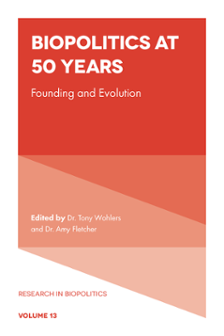
Index
ISBN: 978-1-80262-108-2, eISBN: 978-1-80262-107-5
ISSN: 2042-9940
Publication date: 21 November 2022
Citation
(2022), "Index", Wohlers, T. and Fletcher, A. (Ed.) Biopolitics at 50 Years (Research in Biopolitics, Vol. 13), Emerald Publishing Limited, Leeds, pp. 219-226. https://doi.org/10.1108/S2042-994020220000013012
Publisher
:Emerald Publishing Limited
Copyright © 2023 Tony Wohlers and Amy Fletcher. Published under exclusive licence by Emerald Publishing Limited
INDEX
- Prelims
- Introduction
- Political Science and Biology: Then, Now, and Next
- Politics in Evolution: The First 5 Million Years, and the Next 100
- The Remerging Foundations of a Biopolitical Science
- A Multidimensional Understanding of Human Nature in Moral, Political, and Legal Philosophy
- The Biopolitics of COVID-19: Repercussions for International Relations
- Human Nature and the Policy Process: Expectations from Biology
- Neurotoxicants and Behavior: Implications of ‘Toxicogenomics’ for Public Policy
- Study of Oxytocin in Biopolitics
- Reproductive and Genetic Technology Policymaking and Citizenship Rights
- Neoliberal Governmentality of Immunization: A Biopolitical Perspective on the Vaccines in Turkey
- Index